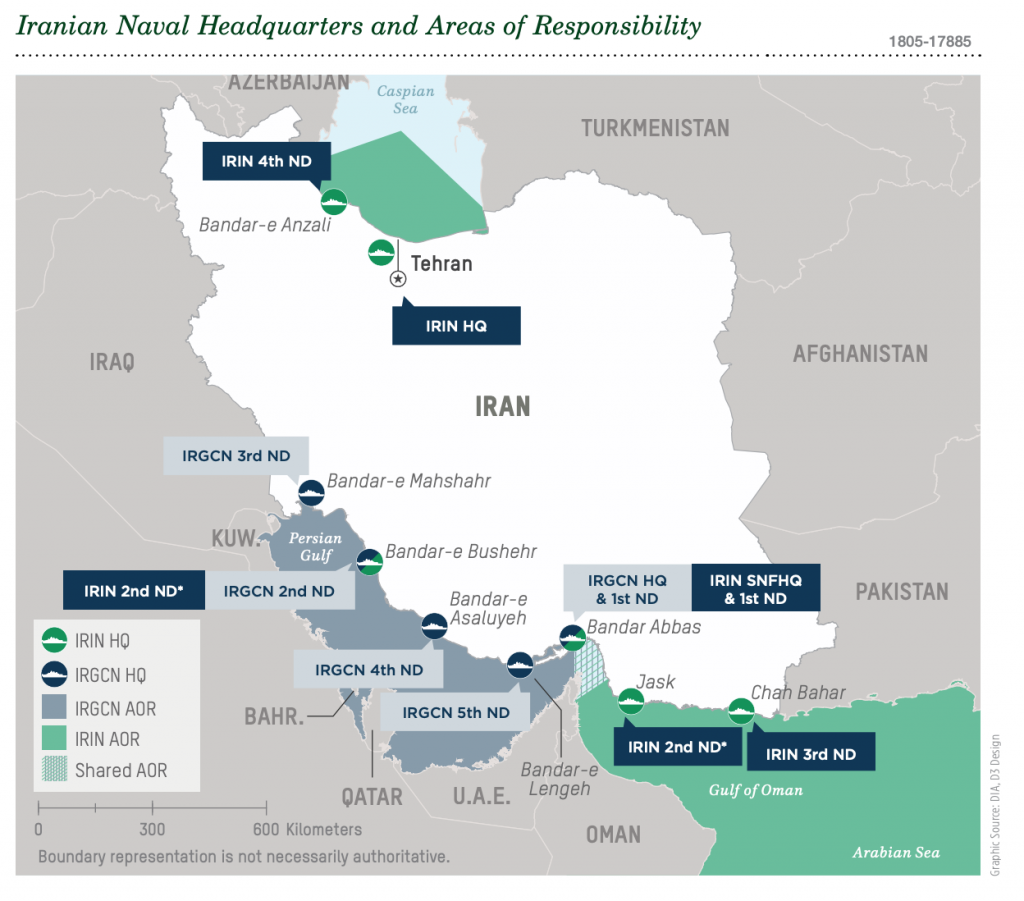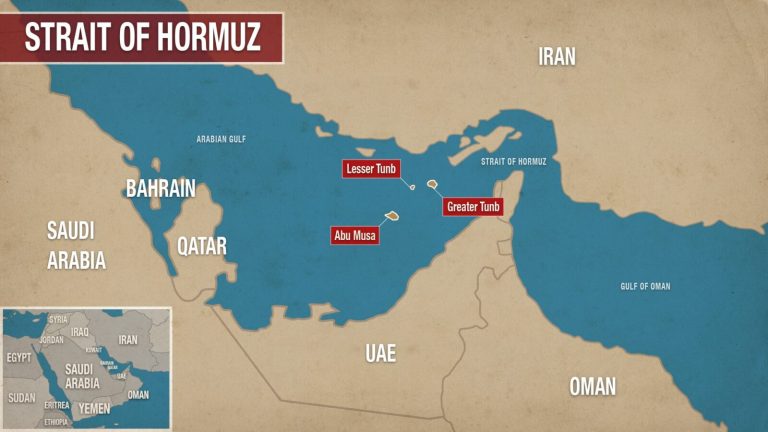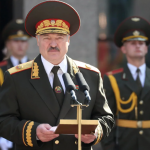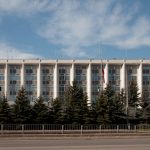Iran is preparing to strengthen its strategic leverage over the Strait of Hormuz amid rising tensions around the Persian Gulf. Tehran is seeking for greater Iranian influence around the strait by expanding its military footprint and building key infrastructure in the area.
More than a third of global seaborne crude oil exports travel through the Strait of Hormuz, funneling almost 21 million barrels per day (bpd) of crude, condensate and refined products from OPEC’s five biggest members. The majority of this is bound for Asia, although the West also relies heavily on supplies from the Strait (refer to chart for the split in volumes).
Strait of Hormuz plays a key role in energy export from the Gulf. According to the U.S. EIA, in 2018, 21 million barrels per day (bpd) of oil flowed through it, or the equivalent of about 21% of global petroleum liquids demand at the time. Iran has threatened to disrupt oil shipments through the Strait of Hormuz if the United States tries to strangle its economy. In January 2012 Iran already threatens to block the Strait in retaliation for U.S. and European sanctions aimed at curbing Tehran’s nuclear program. In July 2018 – President Hassan Rouhani hinted that Iran could disrupt oil trade through the Strait in response to U.S. calls to reduce Iran’s oil exports to zero. Any disruption to this important shipping channel has the potential to impact oil market sentiment. This was shown in June when prices of crude oil surged as much as 4 percent following two attacks on tankers in the Gulf of Oman.
Iran’s efforts reflect contingency planning for a military conflict with the US and its Gulf partners. Tehran will intensify its buildup of conventional military capabilities around the strait in the long-term as the UN arms embargo on Iran expires in October.
The Iranian regime has historically used the Strait of Hormuz to pressure its regional and international rivals. Iranian forces provoked American and British naval vessels, threatened to close the strait to maritime traffic, and attacked international shipping as a response to US pressure campaign.
For the Strait of Hormuz, all waters to the north and east of the traffic lane will form part of the inshore traffic zone within the Iranian territorial waters, which can be easily closed for navigation by the Islamic Republic. However, waters to the south and west of the lane will form a part of Omani territorial waters, but due to the presence of small scattered islands and the lack of sufficient width and depth of navigable water, it will not be possible for big ships to transit, therefore forcing vessels to follow the traffic lane. According to the regional experts, it is not possible for Iran to close the strait citing legal reasons. However, Iran has the ability to mobilize and implement alternate strategies if they decide to intentionally disrupt the flow of traffic through the strait
In August, U.S. Central Command published a black-and-white video showing what appeared to be Iranian special forces fast-roping from a helicopter onto the oil tanker MT Wila, whose last position appeared to be off the eastern coast of the United Arab Emirates near the city of Khorfakkan.
IRGC are adapting their forces for a larger potential escalation. The Iranian conventional Navy (NEDAJA) operates primarily around the Caspian Sea and Indian Ocean and the IRGC is responsible for the Persian Gulf using an asymmetric naval doctrine. The two navies share responsibility for the Strait of Hormuz.
Both Navies also declared plans to expand their basing east of the strait till the end of the Q1 2021. NEDAJA Commander Hossein Khanzadi already restructured two southern naval headquarters in August and announced his plans to further force’s development. Khanzadi also explained plans to enhance the naval districts at Bandar-e Jask and Chahbahar and concentrate fleet there.

IRGC Navy Commander Alireza Tangsiri also described plans to establish a permanent base along the Indian Ocean till the end of Q1 2021. The IRGC maintains a limited forward naval presence at Bandar-e Jask and Chahbahar. Probably he plans to expand the Guards’ existing presence at both location.
Tehran has also modernized C2 of air defense assets around the strait. In October 2019 Tehran established the Persian Gulf Air Defense Operations Command Center. The new center is under the Khatam ol Anbia Air Defense Base.
The NEDAJA and IRGC are also developing their military capabilities around the Strait of Hormuz. The Iranian Army is prioritizing improving its cruise-missile technologies, which are a key component of Iran’s A2/AD strategy in Persian Gulf and Sea of Oman. Khanzadi changed missile unit commander when restructuring the NEDAJA and described plans to acquire Iran’s newly developed Abu Mehdi naval cruise missile.

ran’s paramilitary Revolutionary Guard launched underground ballistic missiles in July 2020 as part of a drills involving a mock-up American aircraft carrier in the Strait of Hormuz, highlighting its network of subterranean missile sites.
Accoding to Michael Elleman, a missile expert at the IISS, Iran also could have used missiles buried in hermetically sealed canisters for the launches without the need for a major underground base.
The IRGC Navy received 112 new patrol and missile attack craft in May this year. It also displayed new tactics during its annual Great Prophet military exercise in the Persian Gulf in July.
Geospatial analysis has confirmed that the location of one of the batteries is on Qeshm Island. The systems seen include the Fajr-3 and Fajr-5 multiple launch rocket systems (MLRS). The Fajr-3 carries twelve 240mm (9.5 inch) rockets. These have a range of 27 miles and carry a large warhead. All twelve rockets can be loosed off in under two minutes. The larger Fajr-5 can hit targets 45 miles away. Only four are carried on each launcher however. Unlike the Fajr-3, which was based on a North Korean design, this rocket appears to be truly Iranian in origin.
Tehran is building energy infrastructure around the Strait of Hormuz to add credibility to its repeated threat to close the passage. President Hassan Rouhani considers plans to construct an oil pipeline from Bushehr province to Bandar-e Jask. The project’s terms are corresponding with plans to establish a permanent base along the Indian Ocean. This pipeline will allow export oil from Bandar-e Jask if the strait “was closed.” Iran currently exports around 90 percent of its oil from Bushehr province via the strait.
An escalation of situation around Hormuz Strait is linked with Tehran’s claims that Saudi Arabia and the UAE are acting against Iran and considers this perceived aggression in the context of the US maximum pressure campaign. Iran is increasingly likely to escalate against US and partner interests around the Persian Gulf and Sea of Oman if pressures increase.
Iran is worrying of growing Saudi economic engagement in Iraq, which could reduce Baghdad’s dependence on Iranian electricity imports. Saudi Arabia improves relations with the new Iraqi government since appointment of Mustafa al Kadhimi as prime minister in May. Iran is a key energy provider to Iraq and wants to deter economic competition there with the KSA.
Iranian leaders condemned the UAE’s normalization of ties with Israel and the Gulf Cooperation Council statement supporting extending the UN arms embargo on Iran. The Iranian threat around the Strait of Hormuz could grow further after the UN arms embargo expires in October. The regime seeks to develop its conventional military capabilities, particularly its missiles, naval forces, airpower, and air defense forces, and will try to procure advanced technologies from China and Russia. The Defense Intelligence Agency notes the regime seeks to field “improved naval mines, faster and more lethal surface platforms, more-advanced [anti-ship cruise missiles], larger and more-sophisticated submarines, and new [anti-ship ballistic missiles].” Iran can turn to aggressive actions against the US and its allies after it finally consolidates forces around the Strait of Hormuz.




